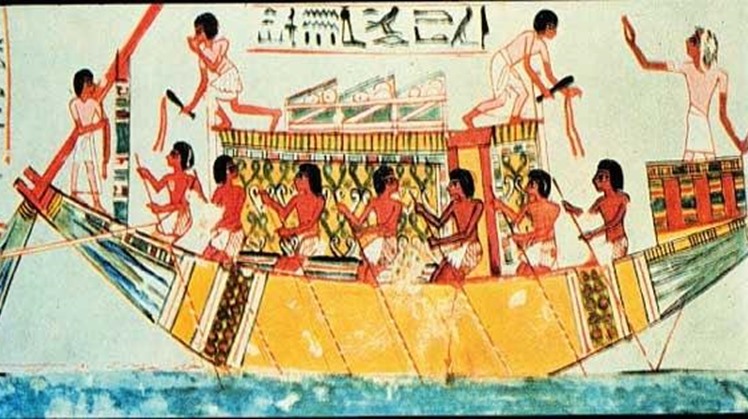On August 15 of every year, this is the anniversary during which the ancient Egyptians celebrated the Nile, where they made sacrifices to the god my love (Lord of the Nile), and chanted songs in appreciation of his thanks to the land of Egypt – in addition, her people.
In light of this memory that is still present in the minds, hearts, and behaviors of Egyptians to this day. We try to get to know together the importance of the Nile for the ancient Egyptians and the aspects of the celebration
No one can deny the great importance of the Nile River in the lives of Egyptians. He and life are the same for them, not only now, but since ancient times until the famous Greek historian, Herodotus openly declared 2,500 years ago that “Egypt is the gift of the Nile,” as if the Nile was the one that gave Egypt. Without it, the civilization that astonished the East and the West alike would not have appeared in this place. Egypt without the Nile is an arid desert.
The name of the Nile is due to the Greek name “Nilus”, and some attribute the word Nilus to Phoenician origins, derived from the Semitic word “Nahl” or “palm”, meaning “running” or “stream” or “river”. However, Diodore of Sicily had another opinion, as he sees that the river originally called Aegyptus, and then it called Nilus, after a king named Nilus, who assumed power and split the canals. Now in many regions of Egypt.
The Nile River originates from Lake Victoria in central eastern Africa, which is one of the three great lakes in the world, then heads north until it reaches the mouth of the Mediterranean, and covers a distance of 6650 km, covers an area of ??3.4 million square kilometers, and passes on its way ten countries African countries called the Nile Basin.
One of the interests of the ancient Egyptians in the Nile River was to establish canals and canals to distribute water to other areas on both sides of the Nile. In addition, since the silt carried the silt with it, it would have been possible for this silt to block these channels and channels had it not been for the ancient Egyptian to continuously refine and clean those channels and devised tools and equipment, including the shadouf whose images appeared on the carved walls. The ancient Egyptians also invented the water wheel, which they used to transport and distribute water from canals and canals to crops, and moved it through huge bulls.
The ancient Egyptians not only cultivated the banks of the Nile, but also exploited the river for fishing, so fish was one of the most important sources of food. They used boats and nets to hunt them, and the walls of tombs and temples still included fishing. Swimming and rowing competitions also held in the Nile, in addition to various marine games.
Among the most important works carried out by the ancient Egyptians: recording the height of floodwaters, and the Ptolemies and Romans developed methods of measuring the Nile, and the instrument was initially a portable instrument consisting of a rolled reed stick. It placed linearly in the course of the Nile to measure the level of the flood and then developed into a ladder carved on its inner walls that covered the measurements with arms. The Ptolemies erected temples on the bank of the river and provided them with Nile scales. In addition, in the nilometer at the temple of Philae, the timing and time of the flood are inscribed. Taxes were calculated based on the flood level of the Nile.
As for what said about the ancient Egyptians throwing a girl into the Nile to drown it, this is a myth for which there is no scientific evidence. It promoted by the Greek historian Plutarch. When he said that “Egyptus”, the king of Egypt, misfortunes struck the country during his reign; the revelation inspired him to guide him to the road, so he advised him to sacrifice his daughter and throw her into the Nile, and he did, then he felt guilty and threw himself into the Nile as well, and he died too. His daughter died. This novel has spread through the ages, making many people under the illusion that it a reality that repeated year after year.
As for “Harris”, there was no mention of the bride of the Nile. In fact, it mentioned that there more than a hundred berths along the Nile between each anchor and the next seven miles, and in each anchor, there was a statue of the Nile goddess who was caring for a priest, and in each of them there were statues of Hapy and the wife of the Nile goddess, the goddess “Rabat” made From silver, gold, tin, tin and various other metals. These statues are thrown into the Nile River on the day of the Habi Festival, just before the flood, and repeated every year.
In fact, the absence of the bride of the Nile among the ancient Egyptians does not reduce their reverence for the Nile, because they sang to it. They presented to the God my love many hymns that repeated in the celebrations of the Flood, and many of them found on the walls of temples, and there are other excerpts from those hymns found in the ancient Egyptian papyri.
Do you want to publish on Apple News, Google News, and more? Join our writing community, improve your writing skills, and be read by hundreds of thousands around the world!
 Wed, Aug. 19, 2020
Wed, Aug. 19, 2020